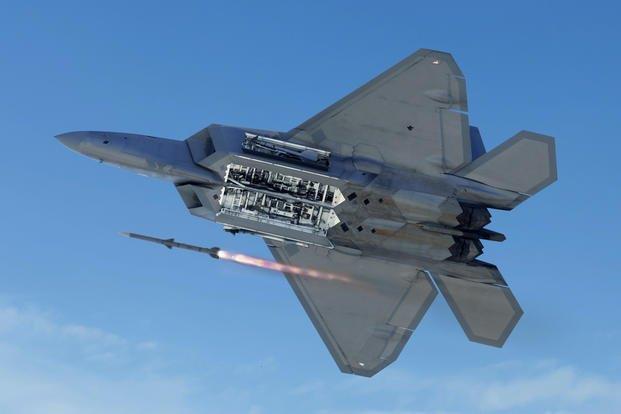(MENAFN- Asia Times) The US plans to ramp up production of its next-generation air-to-air beyond-visual-range (BVR) missile, a weapon it hopes will tip the balance of air power in the Pacific.
this month, the warzone reported that the US Air Force is laying the groundwork for accelerated production of the next-generation AIM-260 air-to-air missile to arm its envisioned Collaborative Combat Aircraft (CCA) fleet of highly-autonomous drones specialized for air-to-air combat.
The report notes that plans to ramp up AIM-260 production follows Air Force Chief of Staff General Charles Brown's testimony to the Senate Armed Services Committee in response to a question on whether the US Air Force has enough missiles to arm its CCAs and other crewed aircraft.
Apart from the CCA, The Warzone notes that the upcoming Next Generation Air Dominance (NGAD) fighter as well as the active service F-22, F-35, F-15EX II and F/A-18 E/F are among the crewed aircraft that will be armed with the AIM-260.
While details about the highly-classified AIM-260 are scant, the warzone notes in a november 2021 article that it may feature a new type of dual-pulse solid fuel rocket motor to ensure consistent flight performance, a hit-to-kill or omnidirectional warhead, multi-mode guidance systems featuring active electronically scanned array (AESA) and infrared seekers and the ability to receive guidance signals from third-party sources such as ground radar, other aircraft, drones and satellites.
Accelerated AIM-260 production comes amid reports that the US air-to-air missile arsenal needs to be updated more quickly to keep pace with US fighter aircraft technology advances.
For example, sandboxx notes in a march 2023 article that the F-35 is currently undergoing a massive upgrade in computational power, known as Tech Refresh 3, a prelude to the Block IV series of upgrades that will give the F-35 a 75% increase in combat capability.
The report says that US next-generation fighters, such as the NGAD and F/A-XX, will need new weapons to leverage the full extent of their capabilities, especially in BVR combat.
In a 2019 article for the International Institute of Strategic Studies, Douglas Barrie notes that the US Air Force can exploit the low-observable characteristics of the F-22 and F-35 with the AIM-260's performance to defeat enemy aircraft with notionally longer-ranged missiles.
Such an approach, Barrie mentions, is not suitable for older fourth-generation aircraft such as the F-15 and F-16. Conversely, newer US aircraft such as the NGAD, F/A-XX, F-22, and F-35 may be handicapped by the aging AIM-120 missile, the current US mainstay for BVR combat.
In a September 2021 article for Air & Space Forces Magazine, John Tirpak notes that while the 30-year-old AIM-120 design has been upgraded over the years, it may have already hit its upgrade potential.
Tirpak also notes that China's People's Liberation Army-Air Force (PLA-AF) has already fielded the PL-15 missile, which may outclass the AIM-120.

The USAF's AIM-120 is apparently inferior to China's PL-15. Image: Illustration
Barrie notes in a september 2022 article for iiss that the PL-15's 200-kilometer range (compared to the 160-180 kilometers of the AIM-120D variant), Mach 5 flight speed, maneuverability and export potential to US adversaries make it a pacing threat for the US and its allies.
Although Barrie notes that the development of the latest AIM-120 variant, the AIM-120D3, was likely driven by the PL-15's performance, the PL-15 may still win out when it comes to delivering a knockout punch to enemy aircraft.
Barrie mentions that the AIM-120D3 relies on trajectory shaping to achieve long-range. That's been done, the writer says, through better software and processing capabilities for more efficient navigation, rather than any modifications to the missile's rocket motor.
However, while that technique gives the AIM-120D3 greater range, delivering enough kinetic energy on the target is critical to ensure a kill.
Apart from possibly not having enough kinetic punch to kill enemy fighters outright, the AIM-120 may also be handicapped by the limitations of semi-active missile guidance.
Joseph Trevithick notes in a march 2023 article in the warzone that the AIM-120 needs to be able to receive launch information from the aircraft before launch, with a datalink between the missile and aircraft necessary to guide the former over longer distances while the aircraft's radar is tracking the target.
Upon closing onto the target, Trevithick says that the AIM-120's onboard active radar would turn on, locking on and guiding the missile independently of the aircraft's radar, giving fire-and-forget capability.
Dave Majumdar notes in an october 2015 article in the national interest that AIM-120D missiles integrated with the F-22 may be vulnerable to digital radio frequency memory (DRFM) jammers developed by China and Russia, which can imitate friendly radar signals and send them back to the transmitter, thereby blinding semi-active radar missiles.
Majumdar says this situation has made it imperative for the US to develop new guidance techniques to defeat DRFM jammers, including through the combination of AESA radar and infrared guidance.

A F-22 firing an AIM-120 missile. Photo: Screengrab / Twitter / Military.com
While the introduction of the AIM-260 aims to preserve US air superiority in the Pacific, it is no high-tech silver bullet for the significant systemic challenges faced by US airpower.
asia times reported in september 2022 that the US suffers from an acute shortage of fighter jets and lags in pilot training, with the US Air Force having only 48 out of 60 fighter squadrons and only 11 out of 13 needed squadrons in the Pacific equipped with aging aircraft that are on average 28.8 years old.
In addition, US pilot training has declined since the 1991 Gulf War, with pilots getting only 9.7 flying hours a month now versus 22.3 hours then. Those numbers are far short of the 137 modernized, well-trained and well-equipped fighter squadrons envisioned to dissuade any rational opponent from picking an air fight with the US.
Like this:Like Loading...